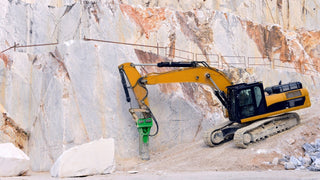From Ancient Techniques to Modern Practices
It is fascinating to consider how ancient civilizations managed to extract massive obelisks and giant granite columns from solid rock, achieving incredible precision long before modern machinery was developed. Initially, quarrying relied on remarkably simple yet effective techniques due to the natural weaknesses present in stone. Early quarry workers used wooden wedges driven into natural joints in the rock and soaked them with water, causing the wood to expand and split the stone apart. Another method involved heating the stone with fire and then rapidly cooling it with water, utilizing thermal shock to fracture the rock.
A fundamental principle exploited in ancient times—and still crucial today—is that a softer stone can be used to cut a harder one. For instance, prehistoric craftsmen in Mexico and India carved jade, a very hard stone, using sticks and abrasive sands such as quartz, garnet, or emery. The Romans innovatively utilized bronze saws coated with similar abrasives, along with chisels and points, for more precise stonework. Today, modern methods utilize steel shot, carborundum, and particularly industrial diamonds, the hardest abrasive available.
Quarrying Today
Modern quarries are bustling, dusty environments where efficiency and consistent quality are essential. Factors such as stone type, quarry location, machinery costs, labor availability, and production demands greatly influence quarrying methods. Traditionally, explosives have been widely used due to their low initial costs, particularly in developing regions and small-scale operations. However, explosives often cause unpredictable fractures, resulting in significant waste material that exceeds the usable stone yield.
Diamond Wire Technology
Diamond wire has revolutionized ornamental stone quarrying over the past 20-30 years. This technology uses heavy wires embedded with diamond beads to cut precisely through hard materials like granite and marble, significantly reducing waste and providing clean cuts. Diamond wire can be utilized in both underground mines and open-air quarries. Although the initial investment is high, the long-term productivity and reduced labor costs justify the expenditure. Additionally, this technology addresses environmental concerns by minimizing waste.
Innovative Techniques: High-Pressure Water Jets
Further advancements in quarrying include high-powered water jets, which effectively cut granite and other hard stones, presenting an environmentally friendlier alternative.
Surface Finishing Techniques
The appearance and final use of stone influence how it is finished. While stone can remain rough, finishing methods enhance aesthetic appeal and functionality:
Polishing
Most decorative stones undergo polishing in computer-controlled production lines. Sheets of stone pass under rotating abrasive spindles, smoothing undulations and progressively refining the surface until achieving a glossy finish that highlights the stone's colors and patterns.
Honing
Honed stone is smooth but lacks the glossy finish of polished stone, resulting in a more matte appearance. Although colors are subtler, natural patterns remain clearly visible.
Sandblasting
Using jets of sand, carborundum, or steel shot, sandblasting slightly roughens the surface, dulling the stone’s color and pattern. This method is ideal for creating designs or inscriptions on polished surfaces, commonly seen in monuments.
Bush-Hammering
Bush-hammering involves indenting the stone surface, creating a distinct textured and non-slip finish. This process, although visually appealing, obscures the stone’s natural patterns and colors, requires significant labor, and is more costly than other methods.
Flaming and Water Finishing
Primarily used for granite, flaming passes a hot oxy-propane flame over the stone surface, creating a granular, non-slip texture. This process can alter stone color, introducing red tints from oxidized iron. Alternatively, high-pressure water jets achieve similar textures by removing softer minerals, applicable to both marble and granite without significantly affecting color.
Final Protective Treatments
Finally, stones often undergo treatments such as impregnation with polymer fillers, strengthening the material and filling any cracks or pores. This is typically performed under vacuum conditions between honing and polishing stages. Additionally, fiberglass or plastic mesh might be applied to reinforce stone slabs further, preparing them for final polishing and eventual installation.

